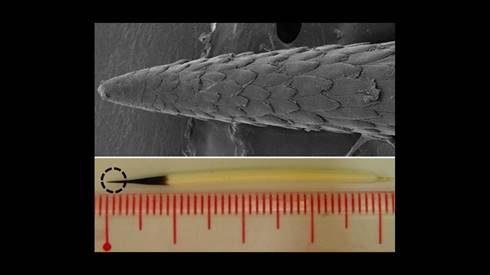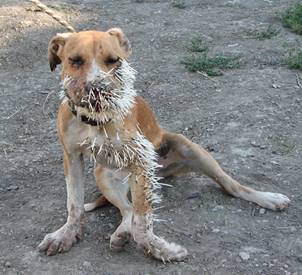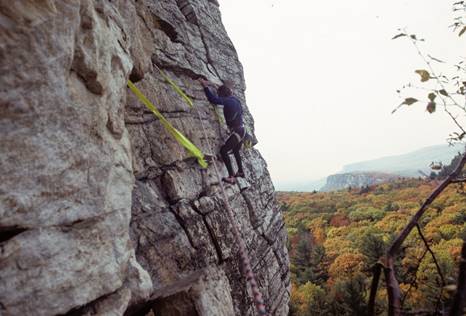I walked out a little distance and met with 2 porcupines which were feeding on the young willow which grow in great abundance on all the sandbars; this anamal is exceedingly clumsy and not very watchfull I approached so near one of them before it percieved me that I touched it with my espontoon. Meriwether Lewis, May 3, 1805 2000-mile creek, NE Montana
Porcupines are the second largest rodent in North American, surpassed in size only by the beaver. As with all rodents, its two front teeth on the top and bottom jaw are constantly growing. Porcupines are found in a variety of vegetation types and with the exception of a few widely separated areas of unsuitable habitat; such as plains, drier deserts, coastal islands, and the SE coastal plain, the porcupine occupies nearly half of the lower United States, nearly all of Canada and Alaska, and part of northwestern Mexico.
They have been described as – uniquely coated, short, obese appearing, bowlegged, pigeon-towed when walking, and obviously myopic. They have a small face and blunt muzzle, shiny and beady eyes, no discernable neck, and a short, muscular, club-like tail. What is not to like here? Oh, and they are covered with about 10,000 barbed quills that are modified hair. As one author notes “It is difficult to misidentify this animal in North America”. Adults weigh up to 13 lbs. with a length of 40 inches.
Let’s get one thing clear – porcupines do NOT throw their quills. I would be a lot more cautious if they did. Instead they will turn their back on a threat and flare their quills so they stand up on end and become more susceptible to dislodging. They have a sharp, barbed end that will pierce skin and painfully lodge there. Porcupines will thrash around their tail when threatened. Woe to the poor dog who has gone after one of these things.


Porcupine quills have proven fatal to many predators and inquisitive animals including dogs, owls, cattle, horses, and even people – though the one recorded human death was from eating a porcupine meat sandwich that contained a quill. If I see that on the menu I will pass, thank you.
Interestingly, the quills have an antibiotic on them so even though a stick is painful it is unlikely to become infected. This is not a courtesy to others, but for self-preservation.
Porcupines climb trees regularly – and sometimes fall out of them – which says something about their gracefulness – and if you are just a giant quill ball being clumsy is not a good thing. So the antibiotic nature of the quills reduces the effects of self-sticking.
They also emit a strong odor to warn away predators, which gets more intense when they are agitated. The smell has been described as a strong body odor, or something like a goat or a strong cheese. The odor is generated by a patch of skin on the lower back called the rosette, where modified quills help broadcast the scent.
Sometimes describing them as clumsy doesn’t quite convey it – Porcupine Rescue
Porcupines are normally solitary animals except during the breeding season and in winter den concentrations. Many people question how these prickly mammals are able to reproduce. Porcupines reach sexual maturity around 1.5 years of age. Mating season is in late fall, where males will follow females around and serenade them with grunts and hums. Females are in heat, or sexually receptive, for a maximum of 12 hours and will be the ones to initiate courtship. Once ready to mate, the female will relax her quills, and moves her tail to the side to allow for the male to mount her.
Females are pregnant for 30 weeks and babies, usually a single porcupette, are born between March and May. Baby porcupines are born with soft quills, which harden a few hours after birth. These babies will nurse up to four months, but are able to start eating green vegetation within a few weeks of birth.
Porcupines are thought to have originated in Africa and made their way across the Atlantic 30 million years ago on vegetation rafts (crossing was shorter then) and landed in Brazil. They eventually made their way across the Panama isthmus once it rose from the sea 3 million years ago. The word porcupine comes from the French word porcespin, which means thorn pig. The Latin, Erethizon dorsatum can loosely be translated to animal with the irritating back.
Porcupines are primarily vegetarians with a winter diet consisting mostly of the cambium and phloem layers beneath tree bark and foliage of woody shrubs and saplings. In the spring they switch from most arboreal feeding to almost exclusively ground feeding on herbs, grasses, and succulent riparian and wetland plants. They are known to damage forestry trees and they have a tendency to chew on things we would prefer they didn’t. Oy Vey
Native Americans used their quills for a variety of decorative purposes on clothes and shoes and used them for artwork.

Bears, cougar, and fisher prey upon porcupines. Fishers, a member of the weasel family, are quick and agile and will run around the porcupine and keep biting its face until it weakens and then it will attack the underside, consuming it from there inward.
I’ve come across these critters fairly often from the east coast to Alaska. Once we were hiking a canyon in eastern Washington, heading back to the car at dusk. 30 feet up a cottonwood tree we saw a porcupine up ahead on the trail and stopped to take a look. He was sound asleep and didn’t notice us.
I was with my brother and another time with a friend back east, climbing at the Shwanagunks in the Hudson Valley, when we came upon a porcupine crossing the old dirt carriage road beneath the cliffs. Both times they asked in trepidation – don’t they shoot their quills!!?? No – and don’t be a baby. I asked my brother to get a stick to keep it from hiding in the talus so I could have time to dig out my camera, but the porcupine was like a little determined tank and just pushed through to a hiding crevice.
The Gunks, as they are known, are located upstate New York, about 1.5 hours from New York City. During the colorful autumn foliage season the area gets a lot of tourists or “leaf-peepers” traveling from the city to see the fall color.
One autumn two of us had just topped out on a climb and were coming down a path and there was a porcupine off the side just hanging out. We passed a group of New Yorkers coming up to look around and as we got lower on the path we heard one exclaim in a great Queens accent – Stella! Look! It’s a POOOR-que-pine.

